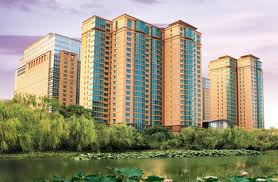When I first got to China and was hunting for an apartment, I was intrigued by the typical Chinese bathroom. The bathrooms are slightly elevated, with the floor sloping towards a drain in the corner. You shower directly on the ground, or in a washbasin. If you’re lucky, you get a Western seated toilet; otherwise the bowls are just embedded in the ground. At one apartment viewing, the enterprising real estate agent tried to convince me that a tiny bathroom, about one square meter, had a “luxury” bathtub because when you showered, you were standing in the toilet.
I adjusted quickly to Chinese bathrooms. It just makes a lot more sense, environmentally, to have smaller bathrooms where you shower on the ground. Water pressure and flow are lower, saving resources, and heat is conserved in a smaller space without extra material (like a tub) to absorb the warmth. Chinese apartments usually have small water heaters in the bathroom, where you can watch the meter and the amount of hot water as you shower. They can be monitored and turned on and off with ease, encouraging resource-saving habits. And, many of them are solar powered! Plus, you clean the floor every time you take a shower. You may think I’m weird for pointing this out, but seriously, cleaning the bathroom floor is the worst.
Back in America, showers seem wasteful. While I was apartment hunting here, I came across an interesting Craigslist posting – an apartment for only $400/month, a suspiciously low price for central Washington, DC. The posting explained that the price was so low because the apartment was under construction, and there was no bathtub – you had to shower on the floor. And for some strange reason, that was deterring prospective tenants! At one point, I would have understood. But after living in China, I just don’t see the point of bathtubs anymore. Unfortunately for the environment, demand for bathtubs in China is growing as living standards increase and people seek to emulate Western lifestyles. Save the Chinese bathrooms!
当我第一次到中国,并正在寻找一间公寓,典型的中国浴室引起了我的好奇。浴室略微抬高,地面倾斜向角落里的排水管道。你直接站着淋浴,或者在浴缸里。如果你幸运的话,你会有一个西式马桶;,否则,它是嵌在地面上。在看意见公寓的时候,房地产经纪人试图说服我说一个小浴室,一平方米左右,有一个“奢侈”的浴缸,因为当你洗澡时,你是站着的。
我迅速适应了中国的浴室。从环境的角度上说,有一个小浴室能让你站着洗澡,的确比较合理。水的压力和流量较低,节约资源,也比较保温,因为这个小控件没有其他材料(如浴缸)来吸收热量。中国的公寓通常有小的热水器在浴室,通过这个你可以查看米,以及淋浴的热水量。他们可以被监控并且地轻松开启和关闭,从而鼓励资源节约的习惯。而且,其中不少是太阳能供电的!另外,你每次你洗澡完都会擦地板。你可能会认为我指出了这一点很怪异,但认真地说,清洁浴室的地板是最糟糕的。
在美国,淋浴似乎是一种浪费。当我在这里找房子时,我看到了Craigslist上面的一个有趣的贴子 – 400美金一个月的公寓,对于一个位于华盛顿中心的公寓来说是一个很可疑的低价。这个贴解释说,价格之所以如此之低,是因为公寓正在建设中,并且没有浴缸 – 你不得不站着洗澡。由于一些奇怪的原因,这吓走了一些潜在租客。曾经我可能会理解的。但在中国生活后,我再也不能理解在浴室放浴缸这件事儿。对环境来说不幸的是,浴缸在中国的需求随着人们生活水平的提高以及人们争相仿效西方的生活方式而增加。请保留中国原本的浴室吧!


